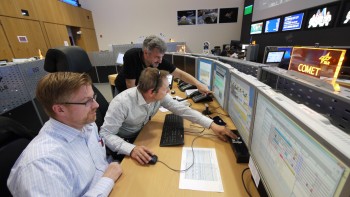Many people support a mission in space. We invite you to meet the teams that are keeping Andreas Mogensen and the International Space Station safe and running experiments, in their own words:
What is your team name?
EPIC
What does your team name stand for?
European Planning and Increment Coordination
What do you do?
We are responsible for coordinating and planning the activities on the timeline for European payloads and for providing messages and procedures in support of daily operations.
EPIC develops the mission timeline in coordination with all other teams, conducts real-time replanning, and supports procedure/message readiness review and uplink. The Columbus Operations and Message Execution Timeline Engineer, COMET, runs the real-time planning and message uplink processes with support from the Columbus Lead Increment Planner, CLIP, and the Increment Lead Operations Controller (IL OC) in the Operations Planning Support Room. The CLIP, IL OC and team planners continually refine timelines before execution and support message/procedure readiness.

A typical timeline but with only three astronauts onboard. For iriss there are nine! Credits: ESA/NASA
What does your work typical day look like?
A typical day for EPIC team members involves coordinating with Mission Directors, Flight Directors, Mission Science Office, payload representatives, Col-CC flight controllers, and International Partner planning teams to support readiness of executing products and integrate our 85 hours of crew activities into the Space Station timelines over a six month increment.
EPIC begins integrating activities into the daily timelines two weeks prior execution and hands over responsibility to the COMET 7 days before an activity is executed (E-7) days. Each day, COMET conducts timeline reviews for E-7, E-3, and E-1 timelines. Iriss timeline development began 9 weeks earlier than usual with MCC-M and MCC-H in order to integrate 50hrs over an 8-day period via nominal processes.
Usually our support is during office hours, but we have the COMET position that is in console between 9:00 and 17:00. To cover IRISS mission we provided 2 COMET shifts (7:00-15:00 and 14:00-22:00) plus additional support in the back room.
How is working for iriss?
Very fast… Usually we have to support astronauts that are working for ESA once or twice a week, during iriss we have an astronaut working with us for 10 days and we support his replanning activities and provide all the necessary information to perform his job. This is like eating in a week all the ice-cream that we usually eat in 6 months.
What is the best part of your job?
Part of the planning that astronauts looking at and work with every day is provided by us and this gives us a big responsibility for the success of the mission.
It is exciting to be part of a unique European team at Col-CC that helps our Columbus Team find and implement solutions to maximize ESA’s science return on the International Space Station in cooperation with our International Partners.




Discussion: no comments